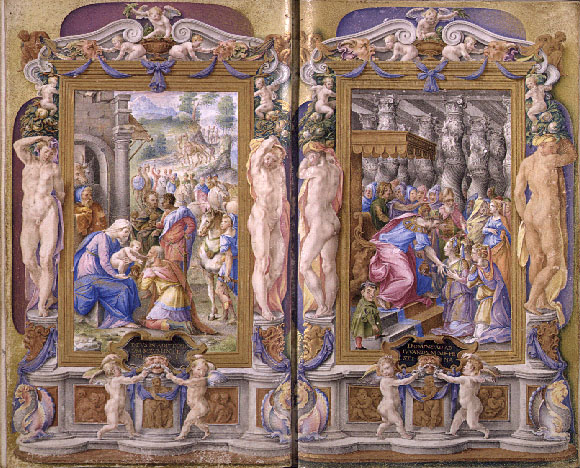|
Renaissance Illumination
Renaissance illumination refers to the production of illuminated manuscripts in Western Europe in the late 15th and 16th centuries, influenced by the representational techniques and motifs of Renaissance painting. With the invention of printing, book painting did not disappear abruptly, but continued in certain luxury manuscripts, and even in some printed works. Illuminators of the period used techniques of perspective representation and iconographic themes specific to the period. Restricted to luxury works, this type of production declined in the second half of the 16th century, as engraving became increasingly competitive. Characteristics New scripts and decorations At the beginning of the 15th century, humanist scholars developed a new script. It was inspired by Romanesque manuscripts of the 11th and 12th centuries, which in turn were inspired by Carolingian texts of the 9th century. The first manuscript written in this script is probably one of the works of Catullus from ... [...More Info...] [...Related Items...] OR: [Wikipedia] [Google] [Baidu] |
Clovio Magi
Juraj Julije Klović (; 1498 – 5 January 1578) was a Croatian-Italian illuminator, miniaturist, and painter born in the Kingdom of Croatia, who was mostly active in Renaissance Italy. He is considered the greatest illuminator of the Italian High Renaissance, and arguably the last very notable artist in the long tradition of the illuminated manuscript, before some modern revivals. Biography Giulio Clovio was born in Grižane, a village in Kingdom of Croatia (today's Croatia).The Life and Works of Giorgio Giulio Clovio, Miniaturist: with notices of his contemporaries, and of the art of decoration in the Sixteenth Century - by John William Bradley – 1891 He came from a Croatian family, Bradley, 2004 (reprint), pp. 368–369 and he is known as ''Clovio Croata.'' It is not known where he had his early training, but he may have studied art with monks at Rijeka of Novi Bazar when he was young. He moved to Italy at age 18 and entered the household of Cardinal Marino Grimani ... [...More Info...] [...Related Items...] OR: [Wikipedia] [Google] [Baidu] |
Italian Renaissance
The Italian Renaissance ( ) was a period in History of Italy, Italian history between the 14th and 16th centuries. The period is known for the initial development of the broader Renaissance culture that spread across Western Europe and marked the transition from the Middle Ages to modernity. Proponents of a "long Renaissance" argue that it started around the year 1300 and lasted until about 1600. In some fields, a Italian Renaissance painting#Proto-Renaissance painting, Proto-Renaissance, beginning around 1250, is typically accepted. The French word (corresponding to in Italian) means 'rebirth', and defines the period as one of cultural revival and renewed interest in classical antiquity after the centuries during what Renaissance humanism, Renaissance humanists labelled as the Dark Ages (historiography), "Dark Ages". The Italian Renaissance historian Giorgio Vasari used the term ('rebirth') in his ''Lives of the Most Excellent Painters, Sculptors, and Architects'' in 1550, bu ... [...More Info...] [...Related Items...] OR: [Wikipedia] [Google] [Baidu] |
Marco Zoppo
Marco Zoppo (1433 – 19 February 1498) was an Italian painter of the Renaissance period, active mainly in Bologna. He was born in Cento. He was a pupil of the painter Lippo Dalmasio then for a few years with Francesco Squarcione around 1455. He was a contemporary of Andrea Mantegna. He painted a number of variations of the ''Virgin and Child Enthroned with Saints'' while he was in Bologna. Francesco Francia was one of his pupils. He died in Venice, where he had gone after working for Squarcione. Artistic career The oldest document in which Marco Ruggieri, known as lo Zoppo, appears, dates back to 1452, when the young painter, living in his native Cento, is entrusted with the gilding of a statue of the Virgin and Child. The following year lo Zoppo is documented in Padua, in the workshop of the ‘tailor and embroiderer’ Francesco Squarcione, whose adopted son he soon became. During these Paduan years, Zoppo was strongly influenced by the art of Donatello, who had recently fin ... [...More Info...] [...Related Items...] OR: [Wikipedia] [Google] [Baidu] |



